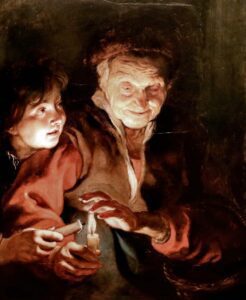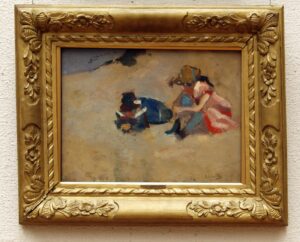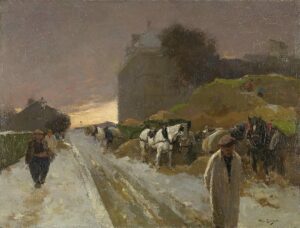The Hague School is a breath of fresh air in the art world, capturing the serene beauty of Dutch landscapes with a subtlety that’s as refreshing as a North Sea breeze.
It’s a 19th-century art movement that brought a new level of realism and emotional depth to the canvas.
We’ll jump into the rich palette and the innovative techniques that set this group of artists apart.
Get ready to explore the quiet revolution that changed the face of Dutch painting forever.
Origins Of The Hague School
The roots of The Hague School can be traced back to the 1860s when a group of artists began congregating in the city of The Hague.
Inspired by the French Barbizon movement, these artists sought to capture the raw beauty of the Dutch countryside.
They were pioneers in their approach, emphasizing the importance of painting en plein air to impart a sense of realism and immediacy in their works.
Key influences on The Hague School included the works of Gustave Courbet and Jean-François Millet, who both reinforced the value of depicting everyday rural life.
The School’s artists also shared a bond with the Realist movement, driven by a deep appreciation for truthful representation without the embellishments characteristic of Romanticism.
Key Contributors To The Hague School
Several artists laid the foundation for The Hague School and contributed extensively to its development:
- Jozef Israëls, known for his emotive portrayal of peasant life, brought a sensitivity to the genre that resonated deeply with audiences.
- Hendrik Willem Mesdag gained acclaim for his panoramic seascapes, harnessing the play of light and shadow masterfully.
- Anton Mauve’s pastoral scenes conveyed the serene quality of Dutch landscapes, influencing his nephew, Vincent van Gogh, who briefly adopted a palette reflecting the somber, earthy tones favored by The Hague School.
These artists and others amalgamated personal techniques with the shared quest for realism.
Their collective effort cultivated an artistic environment in which innovation thrived, setting the stage for subsequent developments in modern art.
Each member brought a unique perspective to the School, collectively elevating it to a prominent position in the art world.
By understanding the origins of The Hague School, we gain insight into the movement that forged a new trajectory for Dutch art.
The dedication to capturing the essence of the Netherlands in a truthful, unglorified manner marked a significant shift from previous artistic conventions, laying the groundwork for a legacy that still impresses art enthusiasts today.
Characteristics Of Hague School Art
The Hague School distinctively wove a tapestry of realism and naturalism through its artworks, showcasing the serene Dutch countryside and the lives of its people.
Atmosphere and light played key roles, often with the aim of evoking emotional responses from the observers.
This focus on mood and feeling was a divergence from earlier styles which emphasized historical or religious themes.
Subtle color palettes characterized the movement, echoing the muted shades found in nature.
Artists employed a range of grays, browns, and greens to not only portray realism but also to compose a harmonious visual experience.
These earthy tones set the stage for scenes of daily life and the expansive Dutch landscapes, solidifying The Hague School’s reputation for its quiet yet compelling visual narratives.
- Techniques and Compositions – Artists of The Hague School adopted innovative techniques that contributed to their unique appeal: * They utilized wet-on-wet painting methods, blending colors directly on the canvas to achieve softer edges and a seamless interplay of shades. * The brushwork was often bold and visible, imparting texture and vitality to each piece. * Compositions frequently implemented unconventional angles and perspectives, drawing viewers into the scenes with immersive depth.
Jozef Israëls’ Aloof and Hendrik Willem Mesdag’s Panorama Mesdag were prime examples of these methods in play, steering clear of the grandiose to capture an intimate glimpse of the quiet magnificence found in the everyday.
By aligning closely with the philosophies of honesty in representation, The Hague School left a permanent imprint on the art world, advocating for simplicity and sincerity in artistic expression.
https://youtube.com/watch?v=cX8HguswGZo
Capturing Dutch Landscapes In A New Light
Artists from The Hague School were pioneers in transforming the portrayal of the Dutch countryside.
They recognized that every aspect of the landscape held a story – the gentle roll of dunes, the chill of morning mist, and the warmth of a sunset over fishing boats.
Their canvases became windows to these tales, marked by an innovative use of color and light that breathed new life into familiar scenes.
In The Hague School’s interpretation, it wasn’t just what was painted, but how it was painted that mattered.

They utilized a palette of muted tones to mirror the subtle beauty of the Netherlands’ skies and fields.
Works like Panorama Mesdag envelop viewers in a 360-degree vista, rich with the hues of the Dutch coast, and demonstrate the remarkable capacity of these artists to render scale and emotion through their distinct approach to landscape painting.
- Techniques – artists used were ahead of their time – Influence – set the groundwork for modern landscape art – Legacy – continues to inspire contemporary artists and filmmakers in capturing landscapes.
The unique methods of The Hague School artists transformed simple scenes from nature into multidimensional experiences.
Where they might have once gone unnoticed, the delicate changes in light from dawn till dusk became the subjects of intense study and the heart of their artistic exploration.
Through their work, they did not merely capture the land; they immortalized the very essence of Dutch life and its environment.
The Influence Of The Hague School On Dutch Painting
The Hague School artists left an indelible mark on the landscape of Dutch painting, ushering in a new era of artistic expression grounded in realism and the raw beauty of everyday scenes.
Their dedication to capturing the fleeting moments of light and mood had a profound impact on the Dutch art scene, considerably influencing the works of later painters, who embraced the subtle yet powerful techniques pioneered by The Hague School.
Besides translating the serene essence of the Netherlands onto canvas, these artists established a legacy that surpassed the boundaries of traditional painting.
The principles they cultivated – simplicity, sincerity, and a deep connection with nature – became touchstones for future generations.
This guidance can be directly linked to subsequent developments in Dutch visual arts, with clear echoes in the Amsterdam Impressionism movement and beyond.
The Hague School’s effects on Dutch painting also extended to how the public engaged with art:
- Art became more accessible to a wider audience, with themes resonating with the common man.
- There was an increased appreciation for the beauty found in humble, unembellished landscapes.
- Painters developed a stronger sense of national identity through the portrayal of typical Dutch environments.
Through their unassuming yet potent portrayal of the Dutch ethos, The Hague School artists fostered a new way of seeing the world around us, one that prized the truth in tranquility.
Even as we craft narratives and visuals in our own work, we draw upon their balanced harmony of light and atmosphere, ensuring that every frame we compose is suffused with an organic sense of place and time.
The Legacy Of The Hague School
The biographical works of Hague School artists are often imbued with the movement’s signature realism.
Their portrayal of landscapes and everyday life fostered a deep appreciation for the Dutch environment.

Filmmakers today cite the Hague School as pivotal in teaching the importance of natural light and mood, elements that are crucial in cinematic storytelling.
Realism paved the way for various art forms to depict authentic stories.
The Hague School’s influence extends beyond paintings and enters the world of film, where the choice of lighting and color creates an emotional narrative.

Works such as Vincent van Gogh’s The Potato Eaters and Jozef Israëls’ Kinderen der Zee echo in scenes where the rawness of expression and attention to ambience are central.
Artists from different disciplines continue to draw inspiration from the Hague School.
Our understanding of visual narrative owes much to their trailblazing techniques – – Utilizing subtle gradations of light to convey emotion.
- Capturing the essence of a moment in time.
- Reflecting social contexts within the beauty of the everyday.
The Hague School’s commitment to documenting the quotidian fostered a newfound respect for life’s unembellished moments.
As documentary filmmakers, we often reference this approach, valuing the authenticity it brings to the screen.
Whether it’s capturing the dichotomy of shadow and light on urban structures or the serene beauty of pastoral settings, the principles of the Hague School guide us in framing our subjects.
Their legacy is also evident in how we approach color grading, a process crucial in setting the tone of a film.
Cinematographers and directors alike seek to recreate the atmospheric conditions that artists of the Hague School mastered.
This mastery of shade and hue adds depth and realism to the narrative – much like the textured layers found in Pannekoekbakster by Jozef Israëls or George Hendrik Breitner’s Girl in a White Kimono.
In the end, The Hague School has laid a foundation upon which countless artistic endeavors have been built.
From the focused aesthetics of filmmaking to the innovations in landscape photography, the School’s impact resonates in the techniques and values we hold dear in our creative pursuits today.
What Is Hague School In Art – Wrap Up
We’ve seen the enduring influence of The Hague School, not only on the Dutch art scene but also on contemporary visual storytelling.
This movement’s focus on realism and the emotive power of light and mood remains a touchstone for artists and filmmakers who strive to capture the essence of life’s everyday moments.
Its principles continue to resonate, offering a timeless blueprint for authenticity in art.
By embracing these lessons, we keep the spirit of The Hague School alive, ensuring its legacy endures in our own creative endeavors.
Frequently Asked Questions
What Is The Hague School And Its Influence On Dutch Painting?
The Hague School was an art movement in the late 19th century that prioritized realism and the depiction of everyday scenes in the Netherlands.
It profoundly influenced Dutch painting by introducing a new style that focused on capturing the fleeting effects of light and atmosphere.
How Did The Hague School Affect Later Artists And Movements?
The Hague School’s emphasis on realism and everyday beauty influenced later painters and movements, including Amsterdam Impressionism, which also valued the portrayal of daily life and light effects in art.
In What Ways Did The Hague School Make Art More Accessible To The Public?
By focusing on ordinary scenes and the Dutch landscape, The Hague School made art more relatable to the general public.
This approach fostered a stronger connection between Dutch citizens and their national identity through the arts.
How Does The Hague School’s Legacy Continue In Contemporary Art And Film?
Contemporary artists and filmmakers are inspired by The Hague School’s use of natural light and attention to mood, which they incorporate into visual storytelling.
This has led to a greater focus on authenticity and ambience in both narrative and documentary filmmaking.
What Role Does The Hague School Play In Modern Cinematography And Color Grading?
The Hague School guides cinematographers and directors in their use of light and color to add depth and realism to the screen.
The movement’s principles help create more emotionally engaging and visually compelling films.


